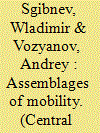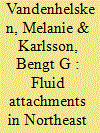|
|
|
Sort Order |
|
|
|
Items / Page
|
|
|
|
|
|
|
| Srl | Item |
| 1 |
ID:
144353


|
|
|
|
|
| Summary/Abstract |
This article addresses reconfigurations of urban space in Central Asia through the lens of marshrutka mobility. Marshrutka-based transport is – together with the bazaar trade – a major sector of Central Asian economy. Although precise data are not available, estimates propose that one family in ten gains its income through it. In spite of its economic and social importance, there has barely been any research on marshrutka mobility so far. The marshrutka mobility phenomenon appears at once wide-ranging and elusive. In order to grasp its complexity, we propose a theory framework based on John Law's concept of fluidity and assemblage. Providing empirical insights from Khujand, in northern Tajikistan, the article addresses marshrutka mobility from a local perspective, notably with regard to regulatory processes of marshrutka-based transport. It also covers the trans-local perspective, with particular attention to global flows of ideas, vehicles, and people.
|
|
|
|
|
|
|
|
|
|
|
|
|
|
|
|
| 2 |
ID:
144686


|
|
|
|
|
| Summary/Abstract |
This introduction presents the context and theoretical basis of fluidity of attachments in Northeast India. A large cultural, linguistic, and ethnic diversity, an international border situation, and various forms of unsettled relations with ‘mainstream India’ characterize Northeast India. These aspects form the frame of highly dynamic movements of identity and ethnicity formation. This special issue includes five papers that focus on these dynamics in terms of ‘fluidity’; they present new situations of shift between different layers of identification, re-signification of cultural practices in the process of their selection as emblems of groups‘ identity, changes in groups’ specific practices after religious conversion, and shifts from one identity to another. They show that shifts of ethnic identity are old processes in the region, whereas other levels of identification, such as lineages, clans, villages, and new ‘cosmopolitan’ identities coexist alongside ethnic identity, and gain particular salience in certain situations or points of time.
|
|
|
|
|
|
|
|
|
|
|
|
|
|
|
|
|
|
|
|
|